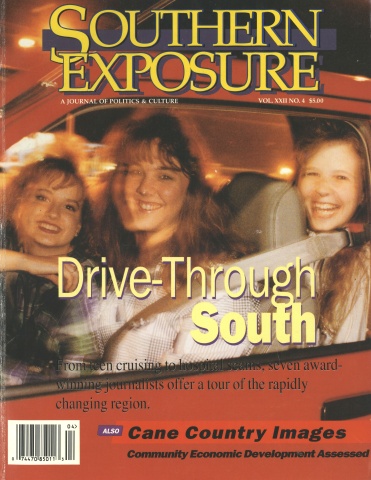The Old South

This article originally appeared in Southern Exposure Vol. 22 No. 4, "Drive-Through South." Find more from that issue here.
Whether they are a “gray peril” feared by some or “the growth industry” courted by others, retirees are heading South in large numbers, giving the term “Old South” a whole new meaning.
In centuries past Southerners died younger, so there were fewer elderly than in other regions. Few social services were available for aging people, so old Southerners tended to stay at home or with adult children. Elderly native Southerners are still the poorest old people in the country. According to census figures, the 10 states with the highest percentage of poor people over age 65 were in the South. Mississippi topped the list with 29 percent poor elderly.
Migration is changing the profile of the Southern elderly population. “Migrants tend to be upper income, healthy, well-educated, and between the ages of 55 and 75,” says Graham Rowles, professor and associate director of the Sanders-Brown Center on Aging at the University of Kentucky. They often move, he says, to places where they’ve had vacation homes or to areas where friends or family have moved.
Florida, with its balmy climate, seaside retirement complexes, and thriving service industry, has long been a favorite destination of the aged, but things are changing. “Florida is still the most popular, but now you have this flow of people back out,” says Rowles. While Florida still attracts more retirees than any other Southern state, Tennessee, North Carolina, South Carolina, and Georgia are also rapidly becoming popular destinations for old people seeking a more moderate climate and sparser population.
“Florida is so flat and full of concrete and cars. It wasn’t for me,” says Edna Arnow. After living her entire life in Chicago, Arnow looked for a place to retire. She chose North Carolina. “I loved the climate. I wanted to be near a university, and when I read about it in the Places Rated Almanac, it had everything I wanted.”
Places Rated Almanac is just one of many books and articles on retirement promoting the South as a temperate and inexpensive haven for the retiree. The authors of The Retirement Book, a guide for planning retirement, say southeastern mountain towns “are centers of lively cultural and social activity.” The southern coastline, they write, “is lovely, with hundreds of offshore islands.”
The region’s charms have succeeded in drawing old people to settle. The Southern elderly population increased 49 percent between 1970 and 1982 and continues to grow. Between 1980 and 1990, the number of residents over 65 in Florida alone increased 40 percent, in South Carolina 38 percent, and in North Carolina 33 percent. While better health care accounts for some of the increase, scholars are finding that much of the change is from immigration, either of newcomers or former residents returning home after spending their working lives elsewhere.
This influx has had a dramatic impact on local residents and their communities. “Older people bring great resources into a community,” says Graham Rowles. “They’ll move their bank account, purchase housing, and generate jobs.” He adds that instead of burdening health services, the elderly attract physicians to rural areas.
Older people also enrich local culture and contribute to the community. “There’s a tendency to think of these people as the ugly outsider coming in and exploiting our folks, but many of these migrants are very concerned about the community,” says Rowles. In Hendersonville, North Carolina, a town of just 7,000 people, retirees helped launch an orchestra, and 80 percent of the county’s volunteers are retired.
While some communities are actively recruiting retired people, others see the retirement industry as harmful. Housing prices and property taxes may rise, pricing local residents out of the market. The jobs generated may be low-paying service jobs, and retirees may come into conflict with local people over land use and services.
In South Carolina’s sea islands, poor African-American communities have clashed with residents of Hilton Head and other wealthy retirement communities. “Retirement communities get basic services like water, sewage, police protection, and the poor communities adjacent to them don’t have such services,” says Emory Campbell, director of the Penn Center, a former freedmen’s school which aims to preserve and develop the black communities of the sea islands. “They say, ‘Look, I’ve got my water and sewage and private road, and I’m not going to pay taxes for yours.’ There’s no sense of responsibility for the total community.”
Whether communities like it or not, old people are a potent force in the South. With more retirees moving here every day, as one Southerner says, “We’d better learn to deal with it.”
Tags
Mary Lee Kerr
Mary Lee Kerr is a freelance writer and editor who lives in Chapel Hill, NC. (2000)
Mary Lee Kerr writes “Still the South” from Carrboro, North Carolina. (1999)